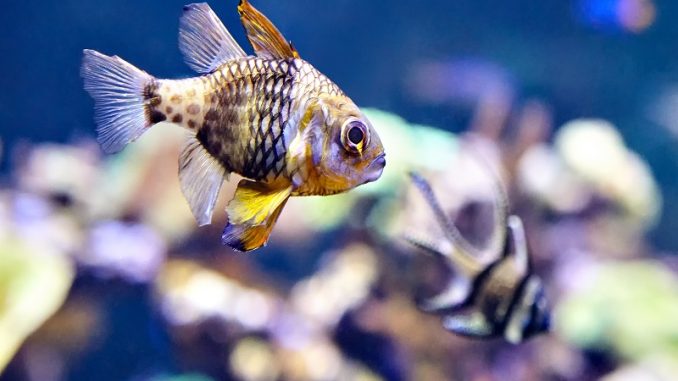
The Pajama Cardinal, also known as the Spotted Cardinal or Pajama Cardinalfish, is a mid-tank schooling fish. You can go with a pair, but Pajama Cardinals will be happier in a group of at least 6.
These fish are ideal for both small and large aquarium communities and are peaceful creatures that will not bully others in the tank. However, you do need to be mindful of the other fish in the tank. Pajama Cardinals absolutely can not be kept with larger predatory fish, as the aggressive fish will view your Pajama Cardinal as a snack; you could lose the entire shoal.
If you are considering staggering active times when curating your tank, you should know that Pajama Cardinals are nocturnal, and will be much more active at night.
Another great feature is that Pajama Cardinals are reef compatible. When you are planning a saltwater tank, it’s good to know which species to avoid if you are housing fish that require reefs in order to thrive.
In this article, I’ll discuss everything you need to know about keeping Pajama Cardinals. I’ll discuss their origins, breeding prospects, nutrition, care, and ideal habitat and water parameters.
TABLE OF CONTENTS
Pajama Cardinal Facts & Overview

| Category | Rating |
| Care Level: | Easy |
| Temperament: | Peaceful |
| Color Form: | Green and white |
| Lifespan: | 5 years |
| Size: | 3 inches |
| Diet: | Carnivore |
| Family: | Apogonidae |
| Minimum Tank Size: | 30 gallons |
| Tank Set-Up: | Saltwater, reef compatible |
| Compatibility: | Peaceful community |
Pajama Cardinals, the scientific name Sphaeramia nematoptera, are native to the Western Pacific Ocean. Not listed as an endangered or vulnerable species, Pajama Cardinals can be found happily swimming all the way from Fiji to Java. Marlin and Dory definitely ran into these guys as they crossed the Great Barrier Reef.
In the wild, the group around the rocky areas of lagoons to rest and hide; at night, they become more active and search for food, preferring small crustaceans. They are carnivores and exist on live food in their natural habitat.
They swim in shallow waters in the ocean, from 3 to 50 feet, so they won’t be bothered by the smaller depth of the home aquarium.
Typical Behavior
These fish are really fun to watch because instead of a wiggly swimming style, Pajama Cardinals float with still bodies, darting from place to place.
Pajama Cardinals are peaceful creatures with others as well as their own kind. However, the males do get somewhat aggressive when they are breeding. By that I mean they are hostile, but not violent.
They do have hierarchical social structures, similar to other schooling fish. Even though they are nocturnal, they are not able to fully hide, and you will see them swimming during the day; they’re just more active at night.
Pajama Cardinals do mark their territory and will find an area of the tank to claim as their home. Even when they go out for food or exploring, they return to their home spot. If there is a rock or coral pattern that has an overhang, you can bet they will choose that spot for their home base.
Appearance
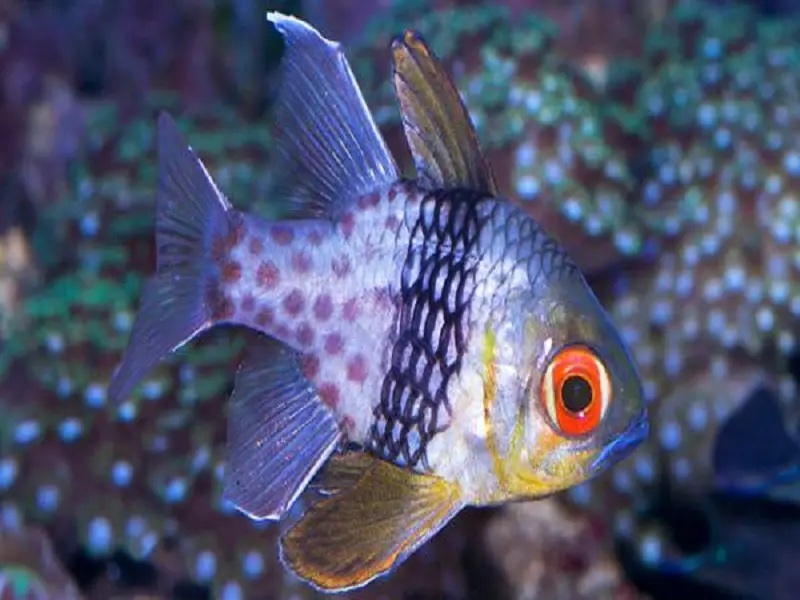
One of the reasons that Pajama Cardinals are unable to fully hide is that they are so colorful! Wow, a small school of these fish will really enhance the aesthetic appeal of your aquarium. Their bodies are silver, but they have many colorful accents, including a black patch located by the dorsal fin and a greenish-yellow face with big orange eyes. The back part of this colorful fish has orange polka dots.
Distinguishing between males and females
The easiest way to tell the males from the females is during the breeding season when the male fish scoops up the fertilized eggs and carries them around in his mouth until they hatch.
Otherwise, you can discern males from females by size (the males are slightly larger), and by the second dorsal fin, which has an extended tip on the males.
Habitat and Tank Conditions
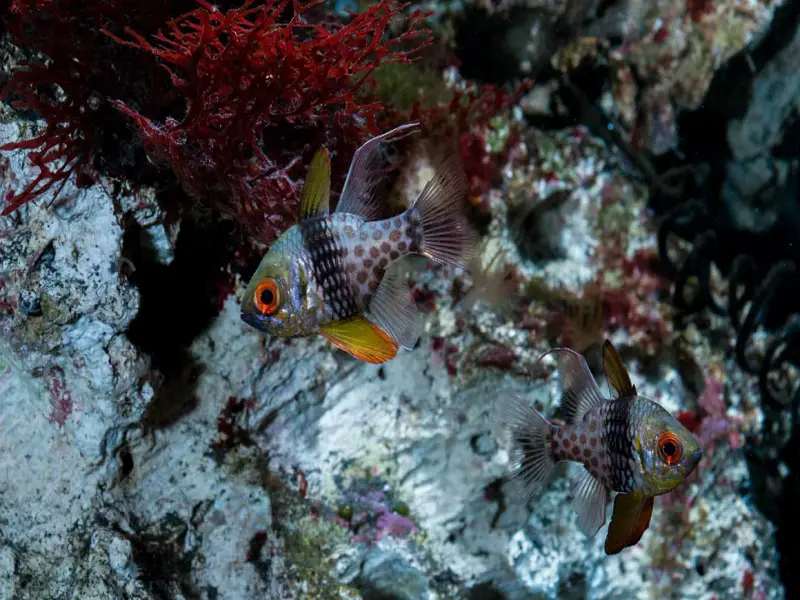
As Pajama Cardinals are mid dwellers, you don’t need to worry about what kind of substrate you use; choose the substrate based on your bottom dwellers.
They do need plenty of hiding places, as they are extremely shy and prefer to stay as hidden as possible during the day. They like caves, rocky overhangs similar to their ocean hiding spots, and coral. They will appreciate seagrass, as well, and will use that as a hiding place, and will even camouflage against sea urchins.
Water Conditions
Pajama Cardinals are rugged fish that are fairly adaptable, but you should keep the water conditions consistent. Unexpected jumps in conditions, even within the acceptable ranges, can be detrimental to the health and well-being of your fish.
Pajama Cardinals need faster currents, so a strong filtration system is a must.
The optimal parameters to ensure the best quality of life for Rosy Red Minnows:
- pH levels: 8.1 to 8.4
- Water hardness: dKH 8-12
- Water temperature: 72° to 79°F (22.2° to 26.1° C)
- Specific Gravity: 1.023 – 1.025
What Size Aquarium Do They Need?
30 gallons is the minimum recommended tank size for a small school of Pajama Cardinals. If you are housing a larger school or other species in a community tank, you’ll have to go up in size from there.
Tank Mates
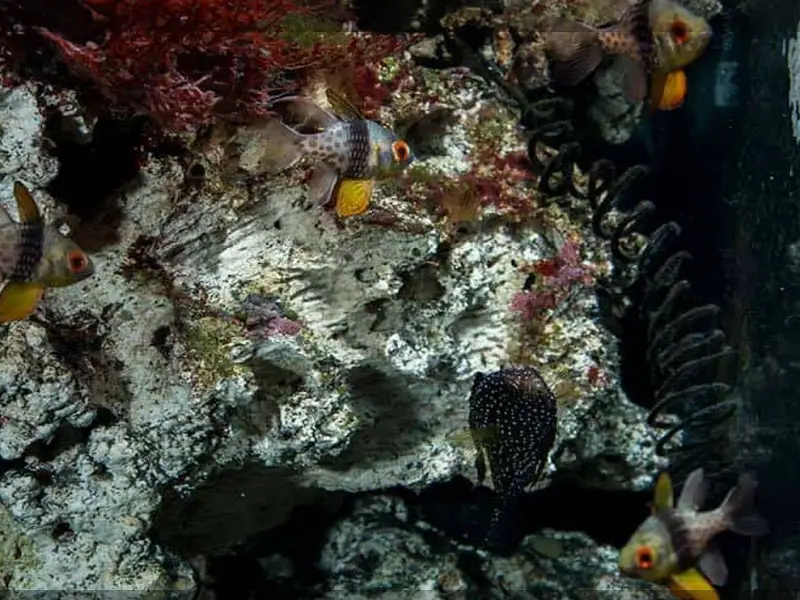
Pajama Cardinals will do well in a peaceful reef tank without aggressive fish. You also want to choose tank mates that dwell in the lower and upper sections of the tank to leave the Pajama Cardinals room in the midsection.
These fish are slow swimmers and might be startled or stressed by fast swimmers in their area.
Suitable Tankmates
Keeping Pajama Cardinals Together
I definitely recommend a school of at least 6 Pajama Cardinals. They are much more likely to thrive when surrounded by the safety and community of a school like they have in their natural habitat. These fish are so passive and timid; they will be less stressed if you keep them together.
You can get away with a pair, but a school is ideal. Plus, a school of these colorful darting fish is so entertaining.
Diet
Pajama Cardinals are micro predators who need meaty proteins. These carnivores need multiple small meals throughout the day. Since they’re nocturnal, you may need to train them to eat during the day.
They are ravenous eaters but slow swimmers, so they might lose the competition for food if there are faster swimmers in your tank.
Good sources of meaty marine protein for Cardinal Pajamas include:
- Bloodworms
- Feeder Shrimp
- Marine Flesh
- Small Feeder Fish
These proteins can be live, freeze-dried, or frozen. You can supplement with flakes and pellets.
Care
Pajama Cardinals are rugged, hardy fish. The best thing that you can do to care for them is to protect them from bullies. I’ve mentioned above that they will not do well with larger, more aggressive fish. In fact, they are so peaceful and timid that they may become the target of harassment by other fish that are similar to them.
Because the Pajama Cardinals are fond of staking out their home territory, you may need to intercede if they are being bullied.
You can rearrange the accouterments in the aquarium, placing rocks, caves, and decorations in different spots. You can also add more decorations to create more hiding spots. You could also try adding more Pajama Cardinals to your tank so that they have a larger community and feel safe and less stressed.
Breeding
You don’t need a special breeding tank or distinct preparations to breed Pajama Cardinals. If you have a mixed-gender school of 6, they will pair off as they mature.
You may need to feed them high-quality foods for a few months to prepare them for breeding, but I suggest such foods no matter the occasion.
Other than that, you don’t need to do anything. In fact, if you don’t want them to breed, you should skip the males and only purchase females.
Pajama Cardinals are mouthbrooders, so the males will forego eating as they hold the eggs in their mouths until they are ready to hatch. During this time, the females will protect the males.
Once hatched, the fry will free swim immediately. You can offer them amphipods, baby brine shrimp, or copepods.
Are Pajama Cardinals Suitable for Your Aquarium?
Pajama Cardinals are a great choice for a midsize saltwater tank. They are reef compatible, have a colorful appearance, and it’s fun to watch them darting around the tank. They’re also peaceful residents who won’t bother others. Beware though–if you keep larger predatory fish in your saltwater tank, you should skip the Pajama Cardinals, who will just become fish food for larger aggressive fish.
I think you’ll really enjoy having these nocturnal beauties to watch–plus it’s always fun to watch a micro predator go after live food.
Do you keep Pajama Cardinals in your saltwater tank? Let me know your experiences in the comments section. Do you keep a pair or a school?

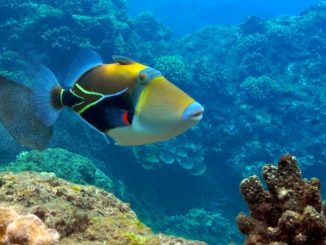
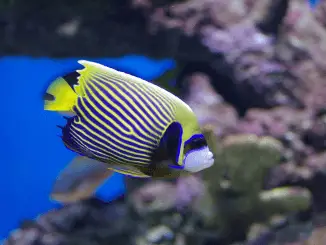

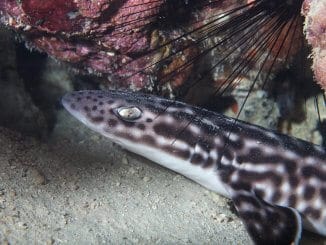

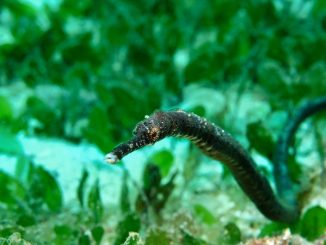
Great article! I’m getting these for my 60 gallon reef tank. So far have a Lawnmower Blenny, Watchman Goby, Pistol Shrimp and Blood Red Cleaner shrimp. What size school is appropriate and beat for this size? 3 or 5?
I purchased two very small pajamas i a 30 gal. One seems to be aggressive towards the other. Im considering separating for now. Is this behavior normal between juveniles? It seems odd hearing how passive they are.